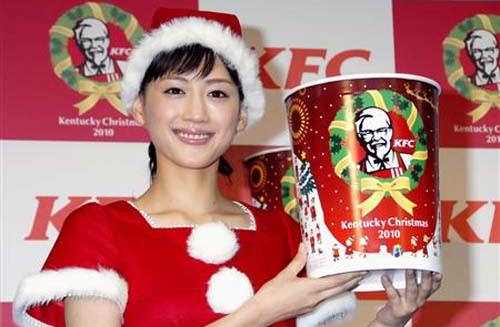One measure of how well you’ve infiltrated your brand into a local culture is how successfully you can align it with local holidays
Seasonal holidays are emotive times, whether it’s a country’s national independence day, saints’ day carnivals, New Year or the mid-autumn festival celebrations in parts of Asia.
Getting the seasonal celebrations right is a big part of aligning your brand with local cultural values and engaging with your audience during a significant time in their calendar. Gift exchange and shared meals are often a big part of festivities and for many brands that represents a big opportunity for sales. Get the holidays right and you have a chance to really bring your brand into every household.

Big brand holiday case studies
KFC is a brand that has managed to transcreate itself with particular success into Japan. The fried chicken retailer ran such a successful seasonal campaign in Japan back in the seventies that eating KFC is now a cornerstone of Christmas celebrations in the country.
Over the decades the brand has continued to repeat the simple message “Kurisumasu ni wa kentakkii!” (Kentucky for Christmas!) to stunning effect. With over a thousand branches in Japan, the chain takes order for the Christmas Eve ‘Party Barrel’ up to three months in advance and there are long queues at KFC stores on the 24 December. KFC is now part of the way Japan celebrates Christmas to such an extent that the national airline has even served branded KFC meals for 3 months in the run up to Christmas.
Other food retailers have offered their own take on local holiday customs. The mid-autumn festival (Zhōng Qiū) is one of the biggest holidays in China and Thailand and involves the gifting of mooncakes. Starbucks integrated into this food ceremony in their own way, offering their own twist in the Hong Kong market by offering flavours such as salted caramel.
In Thailand McDonald’s chose not to reinvent the traditional flavours and instead offers the durian andsalted egg flavour which only seems to appeal to the Thai palate! The fast food chain’s biggest twist on the tradition is more about the pricing – McDonald’s mooncakes are significantly cheaper than comparably-wrapped products from other retailers.
Coke boldly tackled the emotional themes of Chinese New Year with a standout campaign that reunited migrant families. This was a clear attempt to link Coke as successfully with Chinese New Year as it is linked with Christmas in the West (remember Coke helped popularise the image of Santa).
In Malaysia the brand achieved a 43% sales in increase by aligning itself with New Year festivities. Incorporating auspicious characters including ones meaning ‘happiness’ and other inspired by symbolic new year dishes into the label design meant that Malaysians were keen to give the bottle a place on their table during the festivities.
Beware the subtleties of difference
Just because your culture shares a holiday with another, it doesn’t necessarily mean your customs are the same. Beware of marketing your own version of a holiday overseas as your brand’s ‘accent’ may show most at these significant times in a cultural calendar.
In Serbia, Christmas is celebrated on the 7th January and it’s uncommon to exchange gifts on that day. Instead there are set days in the preceding weeks to distribute gifts to men, women and children on dedicated days. Any marketing you do needs to be aware of the pace of events like these.
In Brazil it’s too hot for a fur-trimmed suit, so Santa wears red silk. In Russia, forget Santa: it’s Father Frost who hands out gifts. Russians also celebrate Christmas on the 7th January. Since 1992 Christmas has become a national holiday in Russia, as part of the ten-day holiday at the start of every new year.
The Christmas festive season paces itself differently across different cultures: the UK puts out the seasonal decorations especially early but most festivities stop abruptly after the 25th December.
In the Philippines things also start early but the season carries on past Christmas Day with public holidays on both the 28 December and 6 January and additional religious occasions marked later in January.
Be aware that in many cultures (such as Spain, Mexico and Brazil) most of the big family gatherings take place at midnight. Don’t waste advertising money on campaigns for people who aren’t awake! Similarly, you should be aware of how much people start to wind down as a holiday approaches and avoid using business email addresses over holiday periods.
In some parts of Europe, such as Finland, you can expect the main celebrations of Christmas to occur on Christmas Eve, whereas in the UK it tends to be more about the 25th.
In Europe and parts of the Caribbean there’s a spike in seasonal activity on St Lucy’s day on 13 December, with Christmas decorations often displayed. Review the timing of your campaigns to accommodate the pace of the festivities and catch people at the right time.
Winning strategies for local seasonal holidays
- Don’t make the mistake of merely translating your content into local languages. It’s vital that you also align your message with the expectations and interests of that culture. At holiday time, it’s all about striking the right emotional pitch.
- Spend a long time observing what the competition are doing and understanding the norms of the season. However, the most successful campaigns are ones that stand out from the herd. Coke’s use of the rural children of migrant workers in their emotive New Year campaign stood out in a market where most advertisers turn to celebrities to front their seasonal campaigns.
- Testing your campaign, monitoring it and learning from your brand’s experience are of course fundamental. But consider also engaging in qualitative analysis as well as quantitative analytics-based measurement. It’s worthwhile engaging with focus groups, particularly if you are operating in complex cultures where there be multiple cultural identities within one country. China, with its diverse ethnic and regional identities, is an excellent example of this fragmentation.
- If you’re a Western firm marketing a festivity associated with the West, your brand’s origin may be a key part of its appeal. In Japan, Christmas is embraced as an American festival, which is part of the appeal of KFC at this time. You need to understand how your brand is perceived.
- Find a solid partner with local knowledge who can guide you during both the initial transcreation of your brand to a new market and the ongoing journey there. This local knowledge will inform your understanding of holiday periods and how best to market your brand during these times.
- Create dedicated content for that market and that holiday; repurpose existing content from other cultures only with extreme caution and never, ever use machine translations for anything. Purpose-built, high-quality content will boost engagement and benefit SEO.
- Be on top of the devices your markets are using and the channels they are in. Your content needs to be optimised for these channels and devices.
- Last, but not by any means least, you need to ensure that you match Christmas marketing with Christmas logistics. Consumer confidence in flexible delivery options and demand for speedy delivery is high during the Christmas period. This can prove challenging for even the largest carriers. So you need to make sure your company can cope with the increased demand and importantly, deliver on time.

Thanks to
Sophie Smith for sharing their advice and opinions in this post. Sophie Smith is a copywriter at TranslateMedia and digital expert with a particular interest in the start-up scene and doing business in China. Her writing credits include the Independent and the Sydney Morning Herald. An experienced digital strategist, she's worked in the private equity industry and for a variety of companies including Barratt Homes and Thames Water. In addition to her Oxford degree, she has a masters in digital communications from Manchester Metropolitan University..




 Thanks to
Thanks to 



